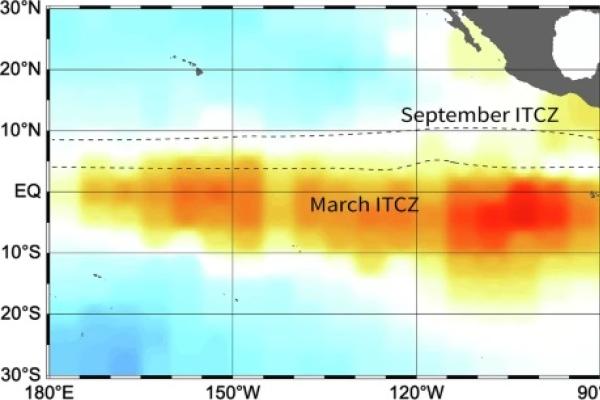Ancient Pacific Sediments Reveal Shifting Tropical Rain Belt Over 30,000 Years

A recent study published in Nature Communications, by Danielle E. Schimmenti in the Department geology and geophysics at Texas A&M University, along with Professor Franco Marcantonio, Dr. Roxana Sierra-Hernandez, a former senior research associate with the Byrd Center's Ice Core Paleoclimatology research group as well as Professor Matthew W. Schmidt (Department of Ocean and Earth Sciences, Old Dominion University, Norfolk, VA) reveals that over the last 30,000 years the Intertropical Convergence Zone (ITCZ)—the band of heavy rainfall near the equator—has shifted north and south by more than seven degrees of latitude in the Eastern Equatorial Pacific.
The research team used a marine sediment core, MV1014-02-17JC, from the Panama Basin and isolated the fine-fraction (<10 μm) dust. Radiogenic lead (²⁰⁶Pb/²⁰⁴Pb, ²⁰⁷Pb/²⁰⁴Pb, ²⁰⁸Pb/²⁰⁴Pb) and neodymium (εNd) isotope ratios were on the marine sediment to establish geochemical "fingerprints." These geochemical "fingerprints" were compared with eleven Provenance Source Areas (PSAs) spanning the Saharan Desert and the Andean margin. These fingerprints allowed them to distinguish dust grains originating from the Sahara Desert in North Africa from those coming from the Andean margin of South America.
Using the Bayesian mixing model MixSIAR, the authors determined how the proportions of North African and South American dust varied during key climate intervals. During cold events such as Heinrich Stadial 1 (approximately 18,000–14,600 years ago) and the Younger Dryas (about 13,600–11,700 years ago), up to 30 percent of the dust in the sediment core was sourced from the Sahara. The researchers suggest that the changing balance of Northern versus Southern Hemisphere dust in the Eastern Equatorial Pacific reflects climate-driven meridional shifts exceeding seven degrees in the average position of the ITCZ, the primary rainfall belt. In contrast, during warmer periods like the Bølling‑Allerød (14,600–13,600 years ago) and the African Humid Period (11,000–5,000 years ago), South American sources—particularly regions such as the Paracas High and Central Western Argentina—dominated the dust record, indicating a northward return of the tropical rain belt.
The study further connects these dust shifts to changes in ocean productivity and carbon cycling. When more Saharan dust fell into the ocean during cold intervals, it likely delivered iron and micronutrients that fueled phytoplankton blooms, enhancing the ocean's ability to draw down atmospheric carbon dioxide. In warmer intervals, reduced dust input would have weakened this biological pump, illustrating the complex feedbacks among atmospheric circulation, marine ecosystems, and global climate.
By resolving dust provenance at sub‑millennial scales, the researchers demonstrate that the Pacific ITCZ experienced much larger migrations than those recorded in Atlantic archives. They attribute this pronounced sensitivity to abrupt Northern Hemisphere cooling, which strengthened cross-equatorial temperature gradients and altered trade-wind patterns in the eastern Pacific Basin. These deep‑time insights into past ITCZ behavior are essential for improving climate models and anticipating future shifts in tropical rainfall, vital knowledge for communities across Central America, northern South America, and West Africa that depend on predictable seasonal rains.
Learn more about the study, "Millennial Pulses of African Dust and ITCZ Shifts in the Eastern Equatorial Pacific"
